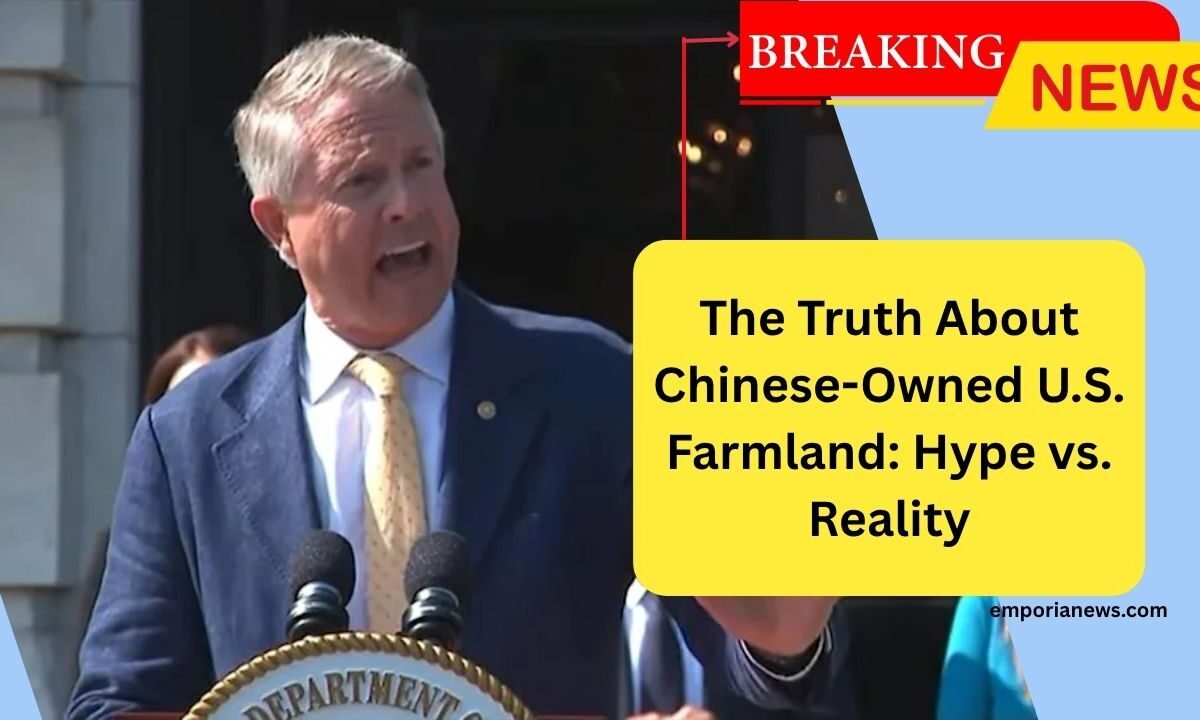On July 8, the Trump administration introduced a new initiative, the National Farm Security Action Plan, citing alleged threats posed by Chinese ownership of American farmland.
Framed as a national security concern, the announcement came amid rising political rhetoric about foreign influence in U.S. agriculture.
However, a closer examination reveals a dramatic overstatement of the issue. The numbers tell a far less alarming story than the administration’s statements suggest.
The Reality Behind the Numbers
How Much Farmland Do Chinese Investors Actually Own?
According to the U.S. Department of Agriculture (USDA), Chinese investors control just 0.02% of all American farmland. That’s two-hundredths of one percent.
In Missouri, the state with the third-highest amount of Chinese-held land, ownership amounts to 42,000 acres, nearly all of which was included in the acquisition of Smithfield Farms. In Kansas, only one acre is owned by Chinese interests.
What Does That Mean for Food Production?
If the entirety of Chinese-owned farmland in the U.S. were planted with wheat, it would only yield about 0.1% of Kansas’s wheat harvest. If it were used for soybeans, it would produce merely 0.16% of Missouri’s 230 million bushel harvest. The scale is negligible.
Who Works This Land?
American farmers and workers cultivate, process, and transport these crops. The produce isn’t stockpiled or hidden — it’s fed into domestic markets, exported through American logistics networks, and in many cases, supports the very trade relationships farm-state politicians publicly champion.
The Administration’s Argument: Shortages and Security
USDA Secretary Brooke L. Rollins warned that Chinese landownership threatens American abundance and could lead to food shortages. However, these claims are not backed by data.
Despite the hyperbolic language, the Chinese-held acreage is minuscule, its output integrated into the U.S. supply chain, and its oversight under a system that has long tracked foreign agricultural investment.
Even so, Senator Roger Marshall, flanking Rollins during the announcement, lashed out, declaring: “China, get the hell out of American agriculture.” A bold stance, especially considering Kansas earns over $4 billion a year from agricultural exports to China.
What the Plan Really Does
Contrary to what was implied, the National Farm Security Action Plan does not ban land purchases by Chinese nationals. Instead, it introduces minor updates to a 40-year-old USDA record-keeping system, allowing foreign land transactions to be reported online.
Notably, Congressional reform proposals for tighter restrictions were dropped from the budget President Trump signed.
The rhetoric suggests sweeping reform, but the policy change is administrative, not legislative. There are no enforcement mechanisms or land seizures included in the plan.
Contradictions in Policy and Action
While claiming biosecurity is a priority, Rollins eliminated 28 scientific positions at Kansas State University’s National Bio and Agro-Defense Facility, and cut 25% of the USDA’s avian flu research staff — even as the plan calls for more investment in disease research. This contradiction undermines the plan’s stated goals.
If foreign landownership is such a grave national threat, why isn’t the administration holding American sellers accountable for enabling it? The plan raises alarms without enforcing any meaningful action.
A Pattern of Fear-Based Governance
The National Farm Security Action Plan fits into a broader trend of fear-based political posturing, echoing the first-term Trump administration’s rhetoric such as referring to COVID-19 as the “China virus” and “kung flu” — language that coincided with a surge in anti-Asian hate crimes.
It aligns with a broader “America First” ideological push, marked by dramatic gestures like immigration bans, anonymous tip lines, and racial profiling of immigrant laborers. Now, it’s farmland in the crosshairs.
Even agencies like the National Park Service have been roped into this culture war, asking visitors whether park information feels “un-American.” Rollins even established a hotline to report Chinese buyers supposedly “sniffing around” for farmland.
Historical Echoes and Dangerous Parallels
These tactics are disturbingly reminiscent of pre-Chinese Exclusion Act hysteria in the late 19th century — an era marked by government-fueled paranoia and racist policies.
In this context, the farm security plan becomes not just a regulatory shift, but a political statement cloaked in agricultural concern.
The Erosion of Truth
As Hannah Arendt once warned, when lies are consistently substituted for facts, public understanding of reality erodes.
The Trump administration’s approach to farmland ownership exemplifies this. The danger isn’t just misleading the public — it’s the destruction of the shared factual framework upon which democracy depends.
Despite the fiery rhetoric and headlines, Chinese ownership of American farmland poses no credible threat to national security, food supply, or American sovereignty.
The real impact is negligible, and the land is mostly used for productive and even renewable energy purposes. What we’re witnessing isn’t policy driven by facts — it’s political theater, part of a broader pattern of scapegoating and misinformation.
Rather than investing in meaningful agricultural protections or improving rural infrastructure, the National Farm Security Action Plan functions more as a megaphone for xenophobia than a safeguard for American farmers.
The real risk lies not in foreign farmland purchases — but in the degradation of reasoned public discourse.




